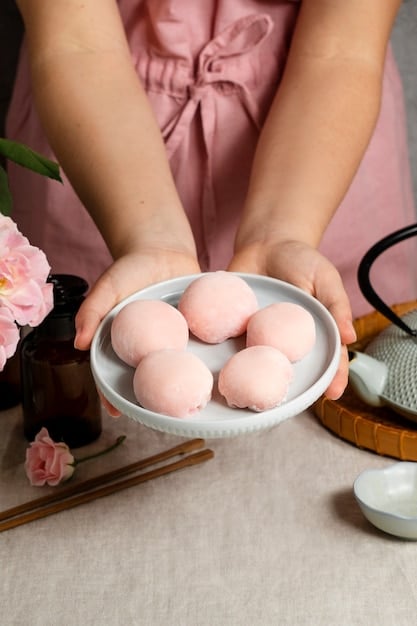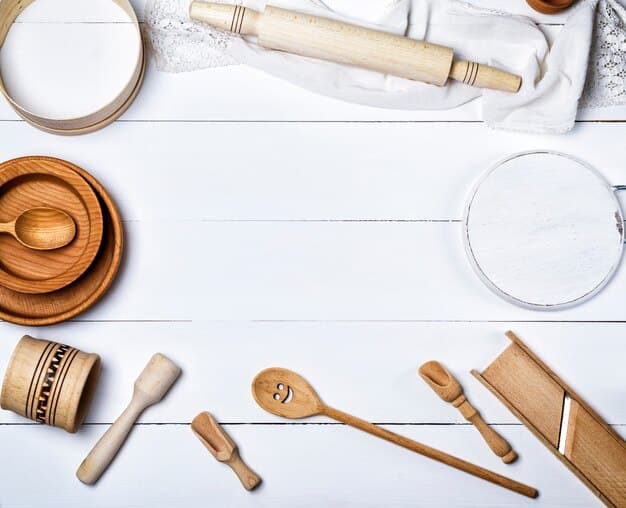Mochi Madness: Your Beginner’s Guide to Homemade Japanese Rice Cakes

Mochi Madness: A Beginner’s Guide to Making and Enjoying Japanese Rice Cakes at Home, explores the delightful world of mochi, offering step-by-step instructions for crafting these chewy treats and discovering various flavors and serving suggestions.
Dive into the delightful world of Japanese sweets with Mochi Madness: A Beginner’s Guide to Making and Enjoying Japanese Rice Cakes at Home. This guide will walk you through the process of creating your own soft, chewy mochi, a versatile treat that’s both fun to make and delicious to eat.
Unveiling the Magic of Mochi: What is it?
Mochi, a staple in Japanese cuisine, is more than just a sweet treat; it’s a symbol of good fortune and celebration. Made from glutinous rice, its unique chewy texture and subtle sweetness make it a beloved ingredient in countless desserts and even savory dishes.
Understanding mochi starts with recognizing its fundamental characteristic: its stickiness. This texture comes from the special glutinous rice used, which transforms into a soft, elastic dough when pounded.
The Origins and Cultural Significance of Mochi
Mochi has deep roots in Japanese culture, dating back to ancient times. Originally used in religious ceremonies and celebrations, it gradually became a popular food enjoyed by all.
- New Year’s Tradition: Mochi is traditionally eaten during the New Year celebrations, symbolizing good luck and prosperity for the coming year.
- Symbolism of Strength: Its sticky and stretchy texture represents strength, resilience, and the bonds of family.
- Versatile Ingredient: Beyond desserts, mochi is used in savory dishes like soups and stews, adding a unique texture and subtle flavor.

Different Types of Mochi to Explore
The world of mochi is vast and varied, with countless regional and seasonal variations. From sweet fillings to savory coatings, there’s a mochi for every palate.
Exploring the different types of mochi offers a delightful journey through Japanese culinary traditions. Each variety showcases the versatility of this simple ingredient, highlighting its ability to adapt to diverse flavors and preparations.
Ultimately, understanding and appreciating the magic of mochi involves delving into its rich history, cultural significance, and diverse culinary applications, offering a more profound connection to this iconic Japanese treat.
Essential Ingredients for Crafting Mochi at Home
Making mochi at home requires just a few essential ingredients, but selecting the right ones is key to achieving that perfect chewy texture and authentic flavor. The star of the show is glutinous rice flour, also known as mochiko.
Choosing high-quality ingredients ensures that your homemade mochi tastes as delicious as possible. Experimenting with different types and brands can also lead to exciting discoveries and personalized flavors.
The Importance of Mochiko (Glutinous Rice Flour)
Mochiko is what gives mochi its signature texture. It’s made from short-grain glutinous rice, which is ground into a fine powder. Don’t substitute it with regular rice flour, as it won’t have the same sticky quality.
Using mochiko correctly is essential. Too much and the mochi can become hard; too little and it might be too sticky. Follow recipes carefully and adjust as needed based on your experience.
Sweeteners and Flavor Enhancers
While mochi itself has a subtle sweetness, you’ll need to add sweeteners to enhance the flavor. Sugar is the most common choice, but you can also use honey or other natural sweeteners.
- Sugar: Granulated sugar is typically used, but powdered sugar can also be used for a smoother texture.
- Honey: Adds a unique flavor dimension and a slightly softer texture to the mochi.
- Other Sweeteners: Experiment with maple syrup, agave nectar, or brown sugar for different flavor profiles.
Water: The Unsung Hero
Water is often overlooked, but it plays a crucial role in achieving the right consistency. Use filtered water for the best results.
The water’s temperature can also affect the final product. Some recipes call for warm water to help dissolve the sugar and activate the glutinous properties of the mochiko.
By carefully selecting and measuring each ingredient, you’ll be well on your way to creating delicious homemade mochi that rivals the best you’ve tasted.
Mochi-Making Equipment: What You’ll Need
While mochi-making doesn’t require an extensive set of tools, having the right equipment on hand can make the process smoother and more enjoyable. From steaming to shaping, each tool plays a distinct role in achieving that perfect mochi texture.
Investing in high-quality equipment not only makes the mochi-making process more efficient but also ensures that your creations turn out consistently delicious.
Steaming vs. Microwaving: Which is Better?
Traditionally, mochi is made by steaming the glutinous rice, but microwaving is a faster and more convenient option for home cooks. Both methods have their pros and cons.
Experimenting with both steaming and microwaving allows you to determine which technique best suits your preferences and produces the results you desire.
Essential Mixing and Shaping Tools
Beyond the cooking method, you’ll need a few basic tools for mixing and shaping the mochi dough. These tools help create a smooth, uniform texture and prevent the dough from sticking.
- Mixing Bowls: Choose bowls that are large enough to accommodate the expanding dough during cooking.
- Spatulas or Wooden Spoons: Use these to stir the dough and ensure even cooking.
- Work Surface: A clean, flat surface is essential for shaping the mochi. Lightly dust it with cornstarch or potato starch to prevent sticking.
Specialty Mochi-Making Gadgets (Optional)
While not essential, there are a few specialty gadgets that can make mochi-making even easier and more fun. These tools are designed to streamline specific tasks, such as portioning and shaping the mochi.
Whether you opt for essential tools or specialty gadgets, having the right equipment on hand will contribute to a successful and enjoyable mochi-making experience.

Step-by-Step Guide to Making Mochi at Home
Now that you’re equipped with the necessary ingredients and tools, it’s time to dive into the mochi-making process. This step-by-step guide will walk you through each stage, from preparing the dough to shaping and filling your mochi.
Following these instructions carefully will help you achieve that perfect chewy texture and delicious flavor that defines authentic mochi.
Preparing the Mochi Dough
The foundation of any great mochi is the dough. Start by combining mochiko, sugar, and water in a microwave-safe bowl. Stir until smooth.
The consistency of the dough is crucial. It should be thick but pourable, similar to pancake batter. Adjust the amount of water as needed to achieve the desired consistency.
Cooking the Mochi
Once the dough is prepared, it’s time to cook it. There are two main methods: microwaving and steaming. We’ll focus on the microwave method for its convenience.
Whether you choose to microwave or steam your mochi, be sure to follow the instructions carefully and adjust the cooking time as needed to achieve the desired texture.
Shaping and Filling Your Mochi
After cooking, the mochi dough will be very sticky and hot. Allow it to cool slightly before handling.
With practice and patience, you’ll master the art of shaping and filling mochi, creating delightful treats that are both visually appealing and delicious.
Delicious Mochi Variations and Fillings
One of the best things about mochi is its versatility. You can fill it with a wide variety of sweet and savory ingredients, creating endless flavor combinations. Here are a few popular options to get you started.
Experimenting with different fillings and toppings is what makes mochi-making so fun and rewarding. Don’t be afraid to get creative and develop your own signature mochi creations.
Classic Sweet Fillings
Traditional mochi fillings often include sweet bean paste, fruits, and flavored creams. These classic options are always a crowd-pleaser.
- Anko (Red Bean Paste): A staple in Japanese sweets, anko adds a rich, slightly sweet flavor to mochi.
- Ichigo (Strawberry): Fresh strawberries are a popular choice for daifuku mochi, creating a refreshing and vibrant treat.
- Custard Cream: Adds a smooth and creamy texture to mochi, complementing its chewy exterior.
Savory Mochi Delights
Mochi isn’t just for desserts. It can also be used in savory dishes, adding a unique texture and subtle flavor. Try wrapping it with nori seaweed or filling it with seasoned meats or vegetables.
Exploring savory mochi options opens up a whole new world of culinary possibilities, showcasing the versatility of this humble ingredient.
Modern and Innovative Twists
Don’t be afraid to experiment with modern and innovative fillings. Try using chocolate, peanut butter, or even ice cream to create unique and decadent mochi treats.
Ultimately, the best mochi fillings are the ones that you enjoy the most. So get creative, experiment with different flavors, and discover your own personal favorites.
Serving and Storing Your Homemade Mochi
Once you’ve created your delicious homemade mochis, it’s important to know how to serve and store them properly to maintain their texture and flavor. Freshly made mochi is best enjoyed immediately, but there are ways to keep it fresh for later.
Proper serving and storage techniques ensure that your homemade mochi remains a delightful treat, preserving its texture and flavor for continued enjoyment.
Serving Suggestions
Mochi can be enjoyed in a variety of ways, depending on the type of mochi and the occasion. Consider these serving suggestions to enhance your mochi experience.
Whether you choose to serve your mochi warm, cold, grilled, or in a soup, the possibilities for enjoying this versatile treat are endless.
Storage Tips
If you have leftover mochi, it’s important to store it properly to prevent it from drying out or becoming hard. There are several methods you can use.
With proper storage, you can extend the shelf life of your homemade mochi and enjoy its delicious flavor and chewy texture for days to come.
| Key Point | Brief Description |
|---|---|
| 🍚 Mochi Basics | Mochi is a Japanese rice cake made from glutinous rice flour. |
| 👩🍳 Essential Ingredients | You’ll need mochiko (glutinous rice flour), sugar, and water. |
| ♨️ Cooking Methods | Mochi can be cooked in the microwave or steamed, depending on preference. |
| 🍬 Filling Ideas | Popular fillings include anko (red bean paste), strawberries, and ice cream. |
Frequently Asked Questions About Mochi
▼
Mochiko is sweet rice flour made from glutinous short-grain rice. It’s what gives mochi that distinctive soft, chewy texture. Substitutions are not recommended, as other flours won’t provide the same result.
▼
Generously dust your work surface and hands with cornstarch or potato starch before handling the cooked mochi. This barrier prevents it from sticking to surfaces and makes it easier to work with.
▼
Yes, mochi can be made by steaming. Place the mochi dough in a heat-proof bowl inside a steamer and cook for about 20-25 minutes, or until it becomes translucent and sticky.
▼
Homemade mochi is best enjoyed fresh, within a day or two. Store it in an airtight container at room temperature. For longer storage, refrigerate or freeze it, but be aware that it may become harder.
▼
Get creative with fillings! Try Nutella, cookie butter, fresh berries with cream cheese, or even savory options like seasoned ground meat or cheese. The possibilities are virtually endless!
Conclusion
Embracing the art of mochi-making at home opens up a world of culinary creativity and cultural appreciation. With this beginner’s guide, you’re well-equipped to embark on your own mochi madness, crafting delightful treats that will impress your friends, family, and yourself. So gather your ingredients, unleash your inner chef, and get ready to experience the joy of homemade mochi!





